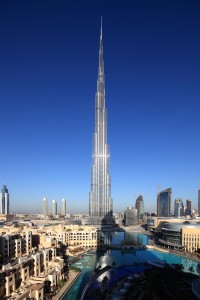Source: www.tradearabia.com
A high quality ternary blend concrete along with other durability enhancing measures were deployed in the substructure of Burj Khalifa, the world’s tallest tower, to ensure its 100-year life span, said a top official of the project.

Substructures in Dubai and in the Gulf region in general, are exposed to a shallow water table with high levels of salinity, which threatens the embedded steel reinforcement with corrosion.
“The combination of a 100 year design-life and the aggressive exposure conditions of Dubai’s environment were the reasons the designer had to carefully consider the durability of the tower’s sub-structure,” said Dr James Aldred, of GHD Consulting Engineers, manager of the Independent Verification and Testing Agency (IVTA) for the Burj Khalifa project.
Standing 828 meters (2,717 feet) tall and boasting more than 160 stories, Burj Khalifa will eventually house 12,000 people.
The significance of designing and building the world’s tallest building, costing over Dh5.5 billion (US$1.5 billion), has become a matter of national pride making the protection of this national asset a priority to the government of the UAE, investors, and the tourism industry.
A migrating corrosion inhibitor (MCI) supplied by United Corrosion Technologies, a corrosion-engineering services provider, was added into the concrete mix. MCI is developed and manufactured by the US-based Cortec Corporation, and utilizes bio-based renewable resources to provide corrosion protection to steel reinforcement.
Usama Jacir, managing director of United Corrosion Technologies, said: “In our region’s harsh environment, steel reinforcement can corrode rapidly, threatening structural strength and necessitating costly repair.”
“Good engineering practice in designing for durability goes a long way in preserving structures and saving operating costs,” he added. – TradeArabia News Service














